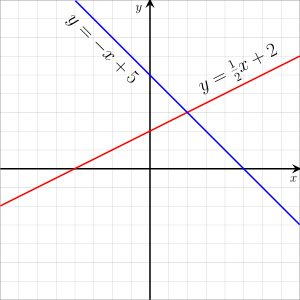
Back Lineêre vergelyking Afrikaans ሊኒያር እኩልዮሽ Amharic معادلة خطية Arabic Ecuación de primer grau AST Һыҙыҡлы тигеҙләмә Bashkir Лінейнае ўраўненне Byelorussian Лінейнае раўнаньне BE-X-OLD Линейно уравнение Bulgarian रेखीय समीकरण Bihari রৈখিক সমীকরণ Bengali/Bangla

In mathematics, a linear equation is a type of equation. A linear equation is the equation of a straight line. This type of equation is written in the form:
or also known as rise over run.
The m is the rate of change or slope.
The slope is how fast the line moves up or down. Numbers farther from 0, or a larger absolute value will make the slope steeper.
If m is a negative number, then the line will appear to fall or go down the page when read from left to right.
If m is a positive number, then the line will appear to climb the page when read from left to right.
While b is the y-intercept of the function.
This is where the function crosses the y-axis of the coordinate plane. The first equation is called slope-intercept form because, in it, the slope (m) and y-intercept (b) are easily found. The second equation is called point-slope form because, in it, a point on the graph (x1, y1) and the slope (m) are easily found.
You can find the slope of a graph by seeing how much the y-value increases by for every one x-value. You can find the y-intercept of a graph by looking at where the x coordinate equals 0, and see what the y-value equals.

